They say… 
Best beer and travel writing award 2015, 2011 -- British Guild of Beer Writers Awards
Accredited Beer Sommelier
Writer of "Probably the best book about beer in London" - Londonist
"A necessity if you're a beer geek travelling to London town" - Beer Advocate
"A joy to read" - Roger Protz
"Very authoritative" - Tim Webb.
"One of the top beer writers in the UK" - Mark Dredge.
"A beer guru" - Popbitch.

|
ABV: 4.5%
Origin: Llanarth, Ceredigion, Cymru
Website: www.penlon.biz
This is an expanded review of a beer that featured as a fruit beer on the bottled beer review page in the August 2010 issue of BEER magazine, sent free every quarter to CAMRA members, who can also view it online. The magazine is also available in selected newsagents.
 This beer's namesake, a Torwen sheep. Tiny farmhouse brewery Pen-Lon Cottage, founded in 2005 in the wilds of Ceredigion by former home brewers Penny and Stefan Samociuk, is one of the few British breweries devoted exclusively to real ale in a bottle, with no cask, opting instead to sell through specialist food shops and markets as a quality artisanal product. The range is impressive, and the commitment to local origin is exhibited two beers featuring local fruit, pale Torddu and dark Torwen, both named after Welsh sheep. The exact fruit used varies according to season and availability.
I sampled a plum version of Torwen, darkened with roasted and flaked barley and hopped with Target. The beer poured near black with a thick creamy beige head. A fresh, lightly roasty and tarry aroma had fruity coffee and new plastic notes, leading to a full but lively dark malt and coffee palate, with a slightly chewy and tannic plum note emerging and both fruit sweetness and acid subtly present in a complex mineral-tinged mix of flavours. More marked fruity flavours emerged on the finish over firm dry chocolate and coffee, with more tannins developing later, a well-judged use of fruit in a thoroughly decent beer.
Buy this beer from AlesbyMail.com as part of a special pack containing all the beers featured on my beer review page in BEER this month. BEER readers receive a special discount by entering the voucher code shown in the magazine.
To download BEER if you’re a CAMRA member, see http://www.camra.org.uk/page.aspx?o=beer.
To find out more about CAMRA membership, see http://www.camra.org.uk/page.aspx?o=joinus.
Read more about this beer at ratebeer.com: http://www.ratebeer.com/beer/pen-lon-cottage-torwen-blackberry/87701/
ABV: 10%
Origin: Innerleithen, Scottish Borders
Website: www.traquair.co.uk
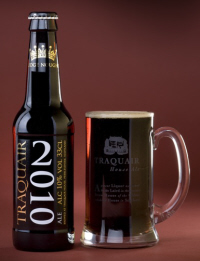 Traquair 2010 An extended review of a beer featured as a strong and special beer on the bottled beer review page in the November 2010 issue of BEER magazine, sent free every quarter to CAMRA members, who can also view it online. The magazine is additionally available in selected newsagents.
The 18th century brewhouse rediscovered and recommissioned at Traquair House, Scotland’s oldest inhabited house, in 1965 remains a unique source of strong and old-fashioned beers, all of which are fermented in the original unlined oak vessels. Owner-brewer Catherine Maxwell-Stuart is also a dab hand at producing special celebration ales with ageing potential. I’m still sitting on a bottle of 2001’s 1000th Brew and was intrigued to see Catherine is marking the second decade of the third millennium with another special, Traquair 2010, in a limited edition of 20,000.
The stylish stencilled bottle contains a deep amber brown beer with a fine, thick beige head and rich malty and spicy aroma with notes of vanilla and cloves. The palate has faithfully Scottish firm and generous malt character that’s slightly cakey but with a light spicy and tangy touch with notes of banana and oak. A long lingering malty finish is slightly powdery dry and perhaps just a little thin and fizzy at the moment, with minerals, wood and vine fruits. Already a luxurious beer that’s big but not overbearing, this should continue to offer a taste experience into 2020 and perhaps beyond.
Buy this beer from http://AlesbyMail.com as part of a special pack containing all the beers featured on my beer review page in BEER this month. BEER readers receive a special discount by entering the voucher code shown in the magazine.
To download BEER if you’re a CAMRA member, see http://www.camra.org.uk/page.aspx?o=beer.
To find out more about CAMRA membership, see http://www.camra.org.uk/page.aspx?o=joinus.
Read more about this beer at ratebeer.com: http://www.ratebeer.com/beer/traquair-2010/125568/
ABV: 7%
Origin: Stoke Lacy, Herefordshire, England
Website: www.wyevalleybrewery.co.uk
 Wye Valley Dorothy Goodbody's Imperial Stout An extended review of a beer featured as a strong and special beer on the bottled beer review page in the November 2010 issue of BEER magazine, sent free every quarter to CAMRA members, who can also view it online. The magazine is additionally available in selected newsagents.
When you’re a brewer puzzling over how to mark an anniversary with a special brew, you could either go out on a limb by doing something completely different, or choose one of your old favourites and give it a special twist. Herefordshire-based Wye Valley is one of Britain’s oldest established new wave micros: in 2010 it’s celebrating its 25th anniversary, having been founded in 1985 by well-known industry figure Peter Amor, whose son Vernon is now MD.
Its outstanding range of bottled beers under the Dorothy Goodbody brand always provides a reliable Real Ale in a Bottle option on supermarket and speciality off license shelves, including one of Britain’s very best bottled dry stouts. So there’s an obvious logic to a limited edition of 6,000 bottles of anniversary Imperial Stout, presented in an attractive presentation box.
Wye Valley makes a virtue of local suppliers and the stout contains Maris Otter pale malt specially grown for the brewery in nearby Canon Pyon, where it was once based, alongside crystal and chocolate malts, roasted and flaked barley, and Northdown and Challenger hops from Penningtons in Madley.
The result is a very dark ruby beer with a bubbly nutmeg head and a milk chocolate and caramel aroma. There’s more chocolate and caramel in the smooth and creamy palate, which is sweetish with touches of blackcurrant fruit and bitter coffee and a notably low condition with only a gentle sparkle. A slightly sticky, cakey finish has more chocolate and a crackle of roast and hops, with a late rooty spiciness emerging.
It’s an unctuous and satisfying beer that’s enjoyable as a bigger sister of Dorothy’s regular Wholesome Stout – but if you’re expecting an imperial stout with challenging and intense flavours, you might be a little disappointed.
Buy this beer from http://AlesbyMail.com as part of a special pack containing all the beers featured on my beer review page in BEER this month. BEER readers receive a special discount by entering the voucher code shown in the magazine.
To download BEER if you’re a CAMRA member, see http://www.camra.org.uk/page.aspx?o=beer.
To find out more about CAMRA membership, see http://www.camra.org.uk/page.aspx?o=joinus.
Read more about this beer at ratebeer.com: http://www.ratebeer.com/beer/wye-valley-dorothy-goodbodys-imperial-stout/129149/
Top Tastings 2010
ABV: 9%
Origin: Tadcaster, Yorkshire, England
Website: www.samuelsmithsbrewery.co.uk
 Samuel Smith Yorkshire Stingo An extended review of a beer featured as a strong and special beer on the bottled beer review page in the November 2010 issue of BEER magazine, sent free every quarter to CAMRA members, who can also view it online. The magazine is additionally available in selected newsagents.
Samuel Smith’s, one of the three remaining historic breweries in the once important North Yorkshire brewing town of Tadcaster and the only one that’s still a family-owned independent, is best known for three things. London real ale drinkers will be familiar with the brewery’s curious estate of pleasantly traditional central London pubs selling their single cask ale, Old Brewery Bitter, at jaw-droppingly low prices. International beer hunters will be familiar with the range of impressive speciality bottled beers they developed mainly for their US importer in the 1990s. And beer writers and researchers will know them as one of the most publicity-shy of all brewers, with not even a website to their name.
Running a business in this way, you rely on the products to speak for themselves, and this they most certainly do. At the cost of some frustration to real ale fans, the speciality bottled range, excellent though it is, has been limited to filtered beers. In 2008, an unexpected exception appeared in the form of Yorkshire Stingo, which is not only bottle conditioned but matured for over a year before bottling in the brewery’s unique collection of oak casks, some of which date back over a century. Stingo is a traditional term in some regions of England for a strong barley wine, but the emphasis on oak ageing reflects the growing interest in wood aged beers in the US craft beer market.
It’s a deep burgundy beer with an orangey-beige head and a malty, cakey and lightly woody aroma, with notes of spiced toffee, grapes and raspberries. A tight, dryish palate is rich with nutty flavours, generous splashes of red fruit and a definite broad oaky note. The finish has that wood-sucking dryness of similarly matured beers but is well balanced by mouth-coating cakey malt, spiced candy and a light peppery bitterness way back in the throat, with some lightly charred notes. A beer that will do nothing to harm the brewery’s reputation for quiet excellence with traditional styles.
Buy this beer from http://AlesbyMail.com as part of a special pack containing all the beers featured on my beer review page in BEER this month. BEER readers receive a special discount by entering the voucher code shown in the magazine.
To download BEER if you’re a CAMRA member, see http://www.camra.org.uk/page.aspx?o=beer.
To find out more about CAMRA membership, see http://www.camra.org.uk/page.aspx?o=joinus.
Read more about this beer at ratebeer.com: http://www.ratebeer.com/beer/samuel-smiths-yorkshire-stingo/90838/
Top Tastings 2010 (JJJ IPA)
ABV: 7.5% and 9.5%
Origin: Pitney, Somerset, Engand
Website: www.moorbeer.co.uk
An extended review of a beeer featured as a strong and special beer on the bottled beer review page in the November 2010 issue of BEER magazine, sent free every quarter to CAMRA members, who can also view it online. The magazine is additionally available in selected newsagents.
 Moor Old Freddy Walker For some reason I’d missed out until recently on the products of one of Britain’s gold starred Real Ale in a Bottle producers, Moor Beers, established in 1996 near Glastonbury but relocated to Pitney in 2008. Since 2007 the brewery has been run by Californian Justin Hawke with his wife Maryan, and they’ve unashamedly pursued a policy of incorporating the vivid flavours of Californian brewing into the British microbrewed real ale tradition. All the beers are well presented in generous 660ml bottles with attractive art nouveau-style labels.
Moor’s best known beer is Old Freddy Walker, an old ale dating back almost to the brewery’s beginning, with a string of awards to its credit. Brewed from pale, lager, crystal and black barley malts and wheat malt, and hopped with Liberty and Bramling Cross, it’s bottle conditioned for at least a month before release and Justin reckons it’s at its peak at least a couple of months after that.
It’s a near-black beer with a thick orangey-beige head and an aroma of chocolate coated raisins with leathery spice and dark malt. The estery, freshly fruity and full bodied malty palate has a leady chocolate note and a sting of roasty, ashy dryness, though within an overall smooth texture also yielding some complex rooty flavours. A dry and bitterish malt cake finish has quite a roasty note developing, with tart fruit, soothing chocolate and lightly spicy hops. The label’s reference to “liquid Christmas pudding” implies something a bit sweet and sickly – but although rich this is a beautifully smooth and fresh beer with a pleasant tart edge.
 Moor JJJ IPA JJJ IPA is even more impressive if only since it’s an unusual style for a British brewery, though it’s dead on for a Californian “hophead” double or triple IPA, and would hold its own among the more celebrated examples of the style. The three J’s are Justin himself, and James and Josh from a nearby pub, who between them developed the beer, which now has a list of awards in its own name to rival Old Freddy Walker.
This deep amber beer has a fine thick yellow head, with toffeeish resiny hops immediately apparent on the aroma, laden with roses, fresh hay and fruit. A lovely rich toasty palate supports a big citric, caramel, cracked pepper and coconut spicy hop bite. The alcohol is warming in the mouth with spirity esters. A long peppery hop finish is warming and slightly tannic with peach stone, artichoke and burnt rubber notes, but plenty of malt to support the bitterness and lend subtlety. A very impressive beer and actually one of the best of its type I’ve encountered.
Buy this beer from http://AlesbyMail.com as part of a special pack containing all the beers featured on my beer review page in BEER this month. BEER readers receive a special discount by entering the voucher code shown in the magazine.
To download BEER if you’re a CAMRA member, see http://www.camra.org.uk/page.aspx?o=beer.
To find out more about CAMRA membership, see http://www.camra.org.uk/page.aspx?o=joinus.
Read more about these beers at ratebeer.com:
http://www.ratebeer.com/beer/moor-old-freddy-walker/29824/
http://www.ratebeer.com/beer/moor-jjj-ipa/83911/
ABV: 8.7% and 10.7%
Origin: Manchester, England
Website: www.marblebeers.co.uk
An extended review of a beer featured as a strong and special beer on the bottled beer review page in the November 2010 issue of BEER magazine, sent free every quarter to CAMRA members, who can also view it online. The magazine is additionally available in selected newsagents.
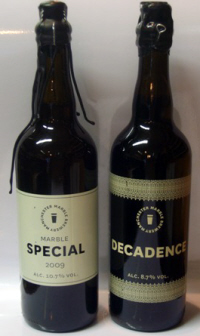 Marble Special and Decade. Pic from the Beer Emporium: www.thebeeremporium.com In a city with more than its fair share of great pubs and bars, the Grade II listed Marble Arch, in rather unpromising surroundings just north of the city ring road at Ancoats, is one of the real stars. Connoisseurs of historic pubs will admire the narrow but high-ceilinged single bar with its impressive ceramic tiling, and diners the excellent food, but the highlight is the first class beer. Most of the cask choices are supplied by the in-house brewery, which is also winning a reputation for itself in the free trade as one of the most imaginative and reliable micros in northern England.
This reputation can only be enhanced by a relatively new line of very special strong limited edition beers, conditioned in 750ml Bordeaux-style bottles with wired and waxed corks, the elegant presentation matching the quality of the content. Many drinkers will raise their eyebrows at the price tag – around a tenner a bottle from the pub, but I for one am glad to see a British brewer daring to up the stakes by putting a realistic price on a fine, rare, artisanal product, a practice now relatively common among the craft brewers of the USA and Italy.
I tasted both Special Barley Wine and Decadence Imperial Stout – both were excellent but the stout impressed the most. It’s near black, with a deep beige head and a dark malt and spice cake aroma with notes of Marmite and tropical fruit hops. A malty, cakey and very smooth palate develops rich fruity flavours – pineapple syrup, lemons, raisins, plums and crystallised ginger – but all with an intriguing bitterish hop lift. More bitter hops assert themselves in a long, drying, lightly roasty finish that develops pineapple, chocolate and charcoal notes. There’s a touch of American influence at work in this very fine example of the style that could clearly withstand some ageing. Frambozen (raspberry) and kriek (cherry) versions are also available.
The barley wine pours a hazy, reddish amber with a fine orangey-white head. There are coconut, farmyard, glucose, grapefruit and boot dubbin notes on very American-influenced hop dominated aroma, and the palate is rich in tropical fruit, pineapple and peach with a lightly bitter and very distinct hop bite. A mouth coating swallow leads to a long-building finish with peach fruit, grapefruit zest, nuts and some alcoholic weight. The hops are firm but not overpowering. The best before date is set 10 years in advance – December 2019 for my sample of brew 1500 from 2009 – and I suspect that with five years in a good cellar the beer will be an absolute knockout, but it’s well worth drinking young.
Buy this beer from http://AlesbyMail.com as part of a special pack containing all the beers featured on my beer review page in BEER this month. BEER readers receive a special discount by entering the voucher code shown in the magazine.
To download BEER if you’re a CAMRA member, see http://www.camra.org.uk/page.aspx?o=beer.
To find out more about CAMRA membership, see http://www.camra.org.uk/page.aspx?o=joinus.
Read more about these beers at ratebeer.com:
http://www.ratebeer.com/beer/marble-decadence/82621/
http://www.ratebeer.com/beer/marble-special/115557/
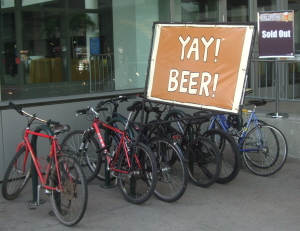 Beer gets on the bike at Denver Convention Center. As a veteran of the Great British Beer Festival (GBBF) visiting the Great American Beer Festival (GABF) for the first time, you’re inevitably drawn to make comparisons. And the one that comes spontaneously to my mind is that the GABF is, well, sexier. Although the GBBF is starting to shift a bit in terms of demographics, at GABF there’s a younger, trendier feel. It’s still predominantly a male crowd — my impression was that the British event is doing rather better in terms of gender balance — but there are notably less beards, beer bellies and decaying T-shirts and notably more strapping crop-haired and heavily tattooed twentysomethings in combat shorts. And though some of my dearest friends have beards and beer bellies, I confess the latter group are easier on the eye.
Curiously, women seem better represented among the ranks of orange T-shirted, Samuel Adams-sponsored Brewers Association volunteers. They, too, are a notably youthful bunch. And before I find myself up on charges of ageism, I should add that it’s not just the age but the buzz — the exhilirating feeling that the event is part of something cuttting edge and brimming with energy. It’s not that the GBBF doesn’t buzz in its way, but it could do with an injection of GABF-style adrenalin.
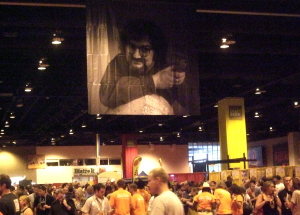 The iconic Michael Jackson presides in spirit, Great American Beer Festival 2010. Such comparisons are apt as the American festival is historically the daughter of the British one. As is well known, GABF founder and US home brewing guru Charlie Papazian got the idea while visiting GBBF in the company of the great Michael Jackson. A much quoted but possibly apocryphal account of their conversation has Charlie saying they should do something like this in the States and Michael replying, in his dry Yorkshire way, “Good idea, Charlie. But what would you do for the beer?” A photo of Michael in his twinkling prime, leaning on a globe with beer glass in hand, now hangs over the extensive bars in the Denver Convention Center, like a beneficient founding father. He’d no doubt take great pride in what they’ve done for the beer since then.
At the 29th GABF, the beers came in over 2,000 varieties from over 460 breweries, and that’s still not even a third of the total breweries now operating in the United States. According to the latest Brewers Association figures, there are 1,640 working breweries, of which almost 1,000 are brewpubs and a mere 20 are big industrial plants. As in Britain, while the overall beer market is shrinking, exacerbated by the recession, sales of craft beer are expanding. The dollar value was up last year by over 10% from 2008, and early figures for this year show the upward trend persisting. But craft beer is still a small fish in a very large pond of yellow rice-based fizz, accounting for only $7billion of the US total of $101billion of beer sales in 2009.
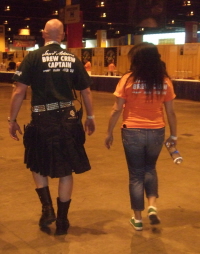 Brew Crew Captain and friend With their native brewing tradition obliterated by Prohibition and the subsequent rise of the megabrewers, American craft brewers started from a clean slate, and the original tendency to clone Old World styles has long since passed into history. US versions of India Pale Ales, laden with the oily bitter grapefruit and pineapple kick of Cascade hops, have become the signature products of the craft brewing movement, and they’re still the biggest sector of the market. But there’s much, much more. Stouts, porters and even pilsners are likely to have their hopping rates and gravities cranked up to 11. Beers of all styles are regularly dosed with wild yeasts and aged in Bourbon barrels and/or flavoured with anything from cocoa pods, chilli and coconut to spruce tips and white sage.
GABF also includes a beer competition, which is more integral to the event than Champion Beer of Britain is to GBBF, and occupies several days of judging time. The competition is style-obsessed to say the least, and to accomodate the burgeoning imagination of brewers there are now 79 recognised style categories, from American-style India Pale Ale to Wood-and-Barrel-Aged Strong Stout. Pity the poor judges who receive a thick volume of definitions before starting work. The home brewing heritage, so important in a country where opportunities to develop the craft professionally were once very limited, is reflected in a Pro-Am strand where home brewers team with commercial brewers to enter newly created beers.
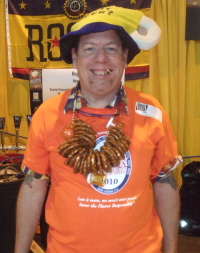 Some aspects of beer festivals are universal. The Convention Center, with its landmark sculpure of a giant blue bear peering through the plate glass, is a vast space, the bigggest indoor venue in the state, bigger than the GBBF’s Earls Court but considerably less crowded. Even so, the atmosphere is hectic. Queues, or ‘lines’ in the local parlance, rapidly form for certain breweries. They also form for the toilets, or ‘rest rooms’ if you prefer the delightful American euphemism, and it’s indicative of that gender imbalance I mentioned earlier that this is the only big event I’ve ever attended where the girls stroll straight in while the blokes line up uncomfortably.
As at GBBF, raucous football crowd roars sweep in waves across the space whenever anyone drops a glass, with somewhat less justification as the “glasses” are made of tough plastic. And as at GBBF there’s a weird thing about daft headgear which runs to foam hats made to resemble hop cones as well as the more usual comedy Viking helmets and beer glasses. Necklaces of empty beer cans and pretzels are other ill-advised fashion accessories.
The format of the festival is rather different, however. Admission to a four hour session is a steep $55, but all the beer is free, so long as you consume it in tiny one ounce servings — 30ml or two tablespoons. In my view that’s too small to appreciate fully both palate and finish. Of course, lines permitting, you can always go back for another pour. Notices on the bars insist pours are accurate, and some servers clearly take pride in being dead on the line, but others, particularly brewers, are more generous. Numbers are strictly limited and in recent years the event has been selling out — this year a record five weeks in advance. I understand the Brewers Association are considering expanding into additional space within the Convention Center.
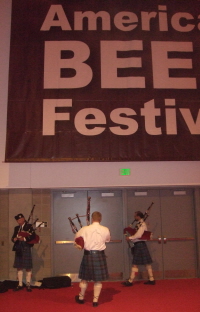 So this is what they meant by making sure your pipes are clean. My press badge got me into all sessions for free, but had I paid, I think I’d have found it a frustrating experience in some ways, making you feel you need to get your money’s worth by working round as many tiny tastes as possible within a limited time. And such small quantities don’t lend themselves to getting a beer and taking it away somewhere to sample at leisure: instead they encourage constant circulation around the bars.
Still there are some very positive and responsible aspects to the way the event is delivered. Designated Drivers get in at a hefty discount, and are treated to free artisanal soft drinks and a massage in their own reserved area. GBBF could learn from the plentiful water stations, where water coolers provide not only drinking water but also the opportunity to rinse your glass.
Like many such events, GABF is catalysing its own fringe festival, with both formal and informal events, often organised by third parties, taking place beside the main one. This is particularly fitting in a city that likes to bill itself as the ‘Napa Valley of beer’, where the Mayor and Democrat candidate for state governer John Hickenlooper is himself the founder of the local Wynkoop brewpub. The various side events in bars and other venues are now being marketed by beer enthusiast and tourism professional Rich Grant of Visit Denver as the Denver Beer Fest.
My press badge got me into a couple of events featuring beer and food pairing. In the Farm to Table Pavilion at the back of the main Convention Center hall, the Culinary School of the Rockies matched chefs with brewers to showcase local ingredients and some truly stunning beers. And the media lunch at the Marriott City Center hotel matched an impressive four courses with beers that were very much fit for table. Following this the press pack — from national newspapers to beer bloggers — were whisked on a coach tour that included the veteran Breckenridge Brewery and Stranahan’s distillery next to the Rackhouse specialist beer pub. I’d love to write about the the smooth, clean, sweetly malty and inexplicably sherryish Colorado whiskey made from 100% Rocky Mountain malt by irrepressible brewer-turned-distiller Jake Norris, but it’s strictly speaking off topic.
 Glasses waiting to filled at the media lunch. We ended up at Wynkoop in the city’s LoDo (Lower Downtown) district for the annual charity fundraising rare beer tasting, this year billed as Pints for Prostates. Most of the beers had gone by then, but it was good to drink what was left in measures bigger than two tablespoons, and in the very pleasant and interesting company of New York City beer and pub videocasters the Happy Hour Guys.
On the Saturday I decided to forego my free admission in favour of drinking proper measures in proper pubs, but found myself at Denver’s leading specialist beer pub, the Falling Rock, just as another special event was getting into gear. For several years now, military medic turned beer expert and all-round character “Doctor” Bill Sysak, now a beer consultant for California brewer Stone’s flagship pub-restaurant, has run a rare beer tasting during GABF week featuring selections from his own 2,000-strong cellar alongside rare beers brought along by participants. For $30 per person, Bill was offering tastes of over 100 rare beers, and I couldn’t refuse.
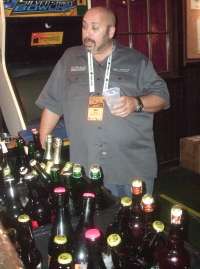 The Doctor is in -- Bill Sysak marshals his rare beers at Falling Rock. Fellow beer writer Patrick, editor of the Albuquerque Beer Scene blog based in New Mexico, heroically took notes on everything, but I abandoned myself to the fireworks display of flavour from Bill’s pours, which included imported delights such as Achel Extra 9.5 Bruin and a limited edition Dupont saison alongside American beer geek pleasers like Lost Abbey Angel’s Share, New Belgium La Folie and a barrel aged version of Ten Fiddy from local heroes Oskar Blues. If anyone still doubts beer can offer a greater spectrum of flavours than wine, I’d recommend a few choice bottles from Dr Bill’s cellar.
Denver wasn’t on my must visit list and I came here only because of the event. But I was pleasantly surprised to discover a fascinating city in its own right. It stands “mile high” at 1600m above sea level on the last westward stretch of the Great Plains, in the shadow of the Front Range of the Rocky mountains. Historically, it’s a frontier town with a history embedded in the less than honorable European colonisation of the North American West. The Colorado Soldier’s Monument just below the Mile High markers on the steps of the State Capitol is scarred by attempts to erase the name ‘Sand Creek’ from its inscribed list of battles — in truth this 1864 “battle” was a massacre of peaceful Cheyenne and Arapaho, mainly women and children.
Something like a natural environment has been restored in the chain of parks that surround the confluence of the South Platte river and Cherry Creek, at the point of the original European settlement. The area is now the focus of a delightful network of off-road walking and cycling trails that, alongside a compact size, good public transport and a cycle hire scheme on the Paris/London model, makes this an easy city to explore without a car.
You can just about get an idea of how it once looked to both Native American and European travellers coming upon these little rivers threaded through the arid plains, and shivering in the looming shadow of the Rockies, their jagged red and purple peaks a wall across the world. The locals shook their heads to see the crazy whites building permanent homes on the riverside, and sure enough the floods came down from the mountains and swept the first town away. Denver today seems rather better prepared for the annual flood of craft beer and the people that drink it.
Beer picks
Great American Beer Festival website: http://www.greatamericanbeerfestival.com
Denver Beer Fest: http://www.denver.org/denverbeerfest
Great American Beer Festival 2010
Top Tastings 2010
ABV: 8.2%
Origin: Harrisburg, Pennsylvania, USA
Website: http://www.troegs.com
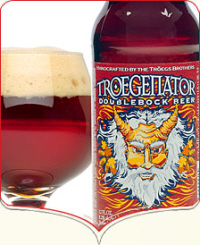 Tröegs Troegenator Doublebock Beer Most of the more celebrated American craft brews are warm fermented ales, but here’s an East Coast microbrewer making a very convincing fist of an original European extreme lager style, the Doppelbock. The name of the brewery exemplifies the delightfully dilettantish multiculturalism of the US craft brewing scene: it’s partly derived from the family name of brothers John and Chris Trogner, who founded the brewery in 1996, but blended with Dutch ‘kroeg’, pub, with the intrusion of a completely unwarranted Scandinavian-style umlaut.
The beer name, meanwhile, apes the German tradition of back-forming Bock brand names with ‘-ator’ on the model of Paulaner’s Salvator. It’s made with Pilsner, Munich and chocolate malts and a relatively modest dose of imported Hallertau and Žatec hops.
This amber beer has a fine yellowy off-white head and a surprisingly light malty aroma. A crisp and biscuity malty palate tastes authentically Bock-like but turns quite dry and yeasty with fruity esters and a chewy nutty note. It’s obviously strong but not overbearingly so. A smooth, tasty, creamy and lightly nutty finish signs the beer off in a well-integrated flourish. Worthy of consideration alongside its German models.
Read more about this beer at ratebeer.com: http://www.ratebeer.com/beer/troegs-troegenator-doublebock/13174/
Great American Beer Festival 2010
Top Tastings 2010
ABV: 9%
Origin: Atlanta, Georgia, USA
Website: http://www.sweetwaterbrew.com
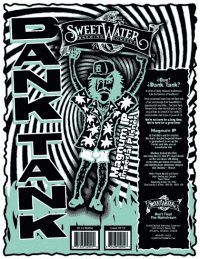 SweetWater Dank Tank Magnum IP Imperial Pilsner If the beers I tried from below the Mason-Dixon Line at the GABF are anything to go by, the craft breweries of the Deep South are quickly catching up with their northern colleagues — although the Dixie credentials of SweetWater brewery are challenged by the fact that Freddy Bensch and Kevin McNerney, who founded it in Atlanta in 1997, originally met as students at the University of Colorado, Boulder.
The Dank Tank series is their range of limited edition beers “from the dark side of our brewers’ souls”. One of them, Magnum IP, was being served in the Culinary School of the Rockies’ Farm to Table beer and food matching pavilion at the GABF alongside some roasted vegetable Napoléon on spent grain crackers with sweet onion jam and micro greens. I admit I’m not a beer and food expert but, while the food was sensational, the beer would have stood out without it.
Magnum IP typifies the American flair for taking an established European style and giving it a merciless twist. IP stands for Imperial Pilsner, for this is a blond lager beer given a turbo boost of alcohol and hops in a manner usually reserved for pale ales and stouts. The hops in question are Cascade and Sterling at 2 pounds per barrel (0.9kg per 117l or 7.7g/l). A brewery representative at the stand admitted to me that they’ve ended up having to brew it at a slightly higher temperature than is typical for lagers, but it does use a cold fermenting yeast and it is properly matured before release.
The beer looks like a classic pilsner, with a rich gold colour and a fine thick white head. A smooth and notably middle European spicy hoppy aroma — Sterling is a recognised American-grown close substitute for Žatec — leads to a wonderfully flowery and smooth palate, rich with vanilla cream offsetting the big hop bite. The finish is bitter but not excessively so, its 100 IBU hopping nicely offset by the high gravity and a creamy malt note. The beer lingers long with a peppery dry bite and a touch of spice. Ovearll it’s a really impressive beer that shows that when it comes to hop colouring, there’s lots of territory still to explore.
Read more about this beer at ratebeer.com: http://www.ratebeer.com/beer/sweetwater-dank-tank-magnum-ip/125585/
Great American Beer Festival 2010
ABV: 5.7%
Origin: Lahaina, Hawaii, USA
Website: http://www.mauibrewingco.com
 Maui CoCoNut PorTeR I’ d been wanting to try this celebrated speciality beer since I met its brewer, the charming Garrett W Marrero, at the Rake in London earlier this year, when he was over to brew a cask version of it for the Wetherspoons beer festival. I never got to taste that version, brewed at Banks’s in Wolverhampton, so I was delighted to run into both Garrett and his beers at the Great American Beer Festival in Denver.
Maui is, perhaps surprisingly, not the only significant player in this far flung outpost of American craft brewing, but has certainly caused a stir far beyond the Hawaiian archipelago since being founded as a modest brewpub in 2005. Among other things it’s noteworthy as one of the US breweries challenging received opinion about canned beer. When the decision was taken to package the beer, cans were chosen principally for environmental reasons and in line with a policy on local sourcing — cans are made on Hawaii while bottles have to be imported from the mainland. They also recycle more easily and using less energy than bottles, and are much lighter to export. Canning technology has improved enough to eliminate concerns about “tinny” taste — over the course of GABF I got to try several craft beers from cans and was impressed to find they were none the worse for it.
CoCoNut PorTeR implements the local sourcing policy by using Hawaiian toasted coconut alongside six varieties of pale and dark malts and a relatively light sprinkling of Cascade and CTZ hops. The result pours a very dark ruby, with a bubbly light beige head. A luxuriously creamy coffee and chocolate aroma extends its smoothness to a big but refreshing palate, very well integrated with toasty brown malts, subtle hops and a definite coconut note. A dry, roasty finish still has that lovely rich coconut touch which compliments the dark malt flavours splendidly, with a powdery dry hop note emerging at the very end. It might sound as a gimmicky as all that erratic capitalisation, but it works amazingly well. A new classic.
Read more about this beer at ratebeer.com: http://www.ratebeer.com/beer/maui-brewing-coconut-porter/59330/
|
Cask  This pioneering new book explains what makes cask beer so special, and explores its past, present and future. Order now from CAMRA Books. Read more here. This pioneering new book explains what makes cask beer so special, and explores its past, present and future. Order now from CAMRA Books. Read more here.
London’s Best Beer  The fully updated 3rd edition of my essential award-winning guide to London’s vibrant beer scene is available now from CAMRA Books. Read more here. The fully updated 3rd edition of my essential award-winning guide to London’s vibrant beer scene is available now from CAMRA Books. Read more here.
|





















